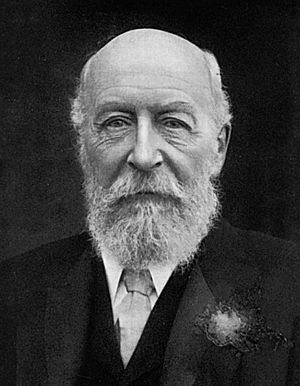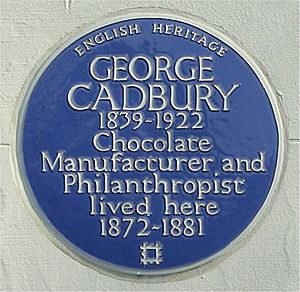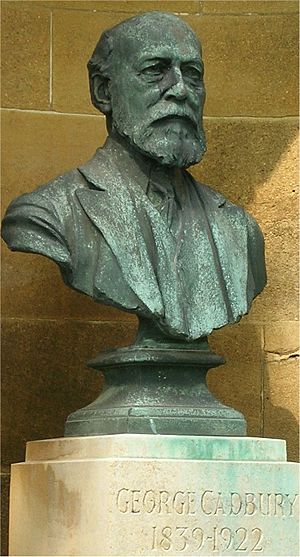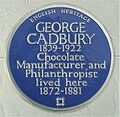George Cadbury facts for kids
Quick facts for kids
George Cadbury
|
|
|---|---|

George Cadbury, aged 78 [1917]
|
|
| Born | 19 September 1839 |
| Died | 24 October 1922 (aged 83) |
| Occupation | Founder of Cadbury's |
| Spouse(s) |
Mary Tylor
(m. 1872; died 1887) |
| Children | 11, including: Edward Cadbury Egbert Cadbury Marion Greeves |
| Relatives | Richard Cadbury (brother) |
George Cadbury (born September 19, 1839 – died October 24, 1922) was an important British businessman. He was the third son of John Cadbury, who started the famous Cadbury's chocolate company. George Cadbury was also a Quaker, a type of Christian faith. He was married to Dame Elizabeth Cadbury. George is best known for helping to grow the Cadbury chocolate business. He also created a special village called Bournville for his workers. He cared deeply about their well-being.
Contents
Growing the Cadbury Business
George Cadbury started working at a young age. He even taught at a Sunday school for adults without pay. He only went to school himself until he was fifteen. In 1861, George and his brother Richard took over their family's business. They worked hard to make Cadbury Brothers a successful chocolate company.
A New Factory and Village
In 1878, the brothers bought a large piece of land. It was about four miles southwest of Birmingham, in the countryside. They opened a new factory there in 1879. They wanted to create a better life for their employees. City life at the time was often dirty and crowded.
So, the Cadbury brothers decided to build a special village. This village was not just for their factory workers. It was designed to offer a healthy place to live. The village became known as Bournville. This name came from a nearby river and the French word for "town."
Life in Bournville
Bournville was very different from the poor parts of the city. Houses there had yards and gardens. Families could enjoy fresh air and green spaces. The houses were never privately owned. This helped to keep their value low and affordable for everyone. Even today, Bournville offers affordable homes.
Caring for Employees
The Cadbury brothers truly cared about their workers. They believed in fair social rights for everyone. They built canteens where workers could eat. They also created sports grounds for recreation.
After his brother Richard passed away, George continued to improve things. He set up committees for both men and women workers. These committees discussed ideas to make the company better. George also introduced other benefits for employees. These included a retirement plan and savings accounts. He also made sure there were good education facilities for everyone.
George Cadbury's Public Work
George Cadbury was also active in public life. He bought a newspaper called Daily News in 1901. He used the paper to speak out against the Second Boer War. He also supported ideas like pensions for older people. He campaigned against unfair working conditions, known as sweatshop labor.
In 1918, George Cadbury helped start The Birmingham Civic Society. This group worked to improve the city of Birmingham. He also gave the Lickey Hills Country Park to the people of Birmingham. This beautiful park is still enjoyed today. He also donated a large house in Northfield. This house became a hospital for children with disabilities in 1909. Today, it is called the Royal Orthopaedic Hospital.
George Cadbury passed away at his home on October 24, 1922. He was 83 years old.
Family Life
George Cadbury was married two times. His first wife was Mary Tylor. They married in London in 1872. Mary was the mother of five of his children: George Jr., Mary Isabel, Edward, Henry, and Eleanor. Mary passed away in 1887.
In 1888, George married Elizabeth Mary Taylor. They had six children together: Laurence John, George Norman, Elsie Dorothea, Egbert, Marion Janet, and Ursula.

Legacy
George Cadbury's impact is still felt today. The George Cadbury Carillon School opened in 2006. It is the only school of its kind in the United Kingdom. A miniature train locomotive is also named after him. It originally belonged to the husband of his daughter, Elsie Dorothea.
Images for kids





